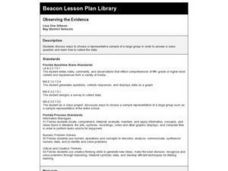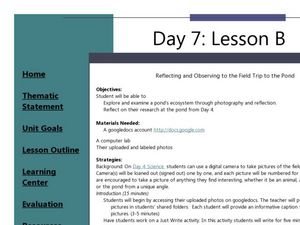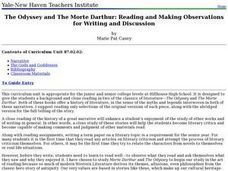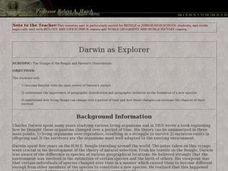Columbus City Schools
You Can’t Sneeze On This Tissue
Take your class' understanding of cells to the next level... or levels! Demonstrate the levels of organization using a variety of engaging methods. The teacher's guide includes the materials you'll need to execute a flower dissection,...
Curated OER
Arthur's Teacher's Trouble
First graders are working on a literature focus unit based on Arthur's Teacher Trouble. The purpose of this language arts lesson is to strengthen observation skills.The teacher will explain the project to the entire class and be...
Curated OER
Observing and Predicting Weather from a Weather Station
Fourth graders us a Weather Log data chart to record the date, time, day, and weather. They discuss different instruments and charts needed to record the information. Students turn in their weather logs at the end of two weeks and...
Curated OER
Sundials: Observing and Using Shadows
Learners build sundials and observe changes in shadows over the course of one or more days. They identify patterns in the shadows and discuss how shadows may be used to tell time.
Curated OER
Observing the Evidence
Fifth graders explore how to do research from a large group. They explore how to choose a representative sample and collect data from it.
Curated OER
Mother-Infant Observation
Students observe a mother and infant playing for ten minutes. In this mother-infant observation instructional activity, students evaluate the infant's activity according to physical characteristics, locomotion, communication, and...
Curated OER
Reflecting and Observing on the Field Trip to the Pond
Learners create an informative caption for photographs taken on a field trip to a pond. In this pond ecosystem lesson, students take photographs and create captions for them. Learners write a reflective essay on a picture they feel...
Curated OER
Observing Rocks
Fifth graders explore the various properties of earth and rocks. They play "Twenty Questions" with the teacher, and analyze a rock using a magnifying glass. They record their rock observations and list the differences between the wet...
Curated OER
Observing Brine Shrimp
Students observe brine shrimp eggs, create an appropriate environment for their survival, and observe their growth.
Curated OER
Observing and Recording Biological Data
Learners create their own definition of life. They identify the eight characteristics of life in organisms. They compare and contrast the characteristics of living and nonliving things.
Curated OER
Explore: 1st Grade Plant Observation
First graders grow seeds in a mini terrarium. They compare the root systems, stems, leaves, and flowers of the different plants. They categorize the plants and discuss the basic functions of plant parts.
Curated OER
The Odyssey and The Morte Darthur: Reading and Making Observations for Writing and Discussion
Students read "The Odyssey" and "The Morte Darthur". In groups, they research the gods and goddesses of Greek mythology and the history of the places mentioned in the stories. Individually, they are to write a paper about a hero they...
Curated OER
A to Z Observations
Eighth graders examine the cultural conflicts that occurred when Europeans moved into the land the Native Americans lived on that would become West Virginia. In this West Virginia history lesson, 8th graders visit the state history...
Curated OER
Looking at Teachers Among Us: A Workshop in Conceptions of Teaching
Students characterize various traditional conceptions of teaching and apply these to authentic teaching situations. Teaching art, math and grading systems are analyzed in this lesson.
Curated OER
Using a Graphic Organizer to Critically Observe Televised News Broadcasts
Students compare two television news broadcasts. They discuss how to organize information when comparing two objects and read and discuss two books to create a Venn diagram to compare both books. After creating the diagram, they view...
Curated OER
Stellar Observations
Ninth graders study the uses of spectroscopy and the operation of the Hubble space telescope. In this astronomy instructional activity students complete a lab activity that includes graphing star color and temperature.
Curated OER
Mystery Cemetary: Teachers
Students examine and analyze the skeletons of various bodies that could represent a cemetary. In groups, they identify a set of common characteristics in which the skeletons are grouped. To end the lesson, they answer questions related...
Curated OER
Activity Three -- Rutherford's Discovery (Student Page ) A Lab Experiment in Physics
This discovery student page offers students an opportunity to work as a team to discover the shape of an object they cannot see. It is an experiment which parallels particle physicists dilemma in not being able to see very small...
Curated OER
Moon Observations
Third graders create a model of the moon and use a flashlight to illustrate the various stages of the moon.
Curated OER
A Teacher's Guide to the Holocaust: Shemini Atzeret-Simhat Torah
Students explore Jewish traditions through Jewish art. In this interdisciplinary lesson, students research art by Moshe Rynecki, Chaim Goldberg and Emmanuel Levy. Students replicate the artistic styles in their own pieces.
Curated OER
The Voyage of the Beagle and Darwin's Observations
Students become familiar with the main events of Darwin's voyage. They comprehend the importance of geographic distribution and geographic isolation on the formation of a new species. Students analyze how living things can change over a...
Curated OER
I'm the Teacher
First graders simulate being the teacher and giving P.E. commands to the class. They each write a sentence and take turns reading their sentence to the class, and after each sentence has been read the class performs the activity...
Curated OER
Graphing Equivalent Fractions
Learners graph families of equivalent fractions and compare them by observing the slope of the line formed by each fraction family. They place fractions in ascending order by comparing the slopes of each line after several families of...
NASA
Discovering Some of Your “Yardsticks” Are Actually “Meter-sticks”
The Milky Way gets great reviews on Trip Advisor — 100 million stars. The activity allows scholars to rethink their assumptions and prior knowledge. Pupils observe a set of two lights at equal distance and brightness, but they believe...

























